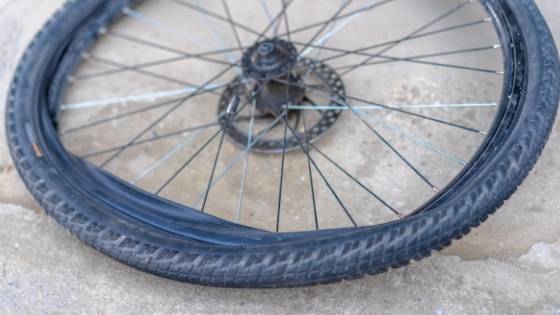
At some point during your cycling journey, you will have to repair and replace your bike inner tubes. It’s definitely part of being a cyclist. And it is very obvious when your inner tube needs replacing.
But what about the tyre itself?
How often should you replace a road bike tyre?
Can you ride your bike for years and never replace the tyre?
Or is it like a car where you should renew them every so often?
On average, road bike tyres will last between 1,000 and 3,000 miles (1600km – 4800km). High-end tyres should last closer to the 3,000-mile mark or more. Consider replacing your tyres every 1,000 miles if you ride regularly or are a competitive cyclist or every 2 years if you’re not counting your mileage.
Not every manufacture of bike tyres use the same materials. Therefore, you need to inspect your tyres regularly.
Here is my post, which explains how long your tyre should last, how to recognise it’s time to replace your tyres and ways to preserve your road bike tyres to extent the life span.

Table of Contents
What’s the Longest Road Bike Tyres Will Last?
Average road bike tyres won’t last more than 3,000 miles, and going beyond that many miles could be dangerous.
Safety while riding should always be your priority and reducing the risk of your tyre splitting during a ride is essential.
Furthermore, if you have had the same tyre on your bike for more than 3 years, the rubber could be weakened, and it could be time to replace it regardless of the milage.
Even if you store your bike inside, the rubber hardens over time, making the tyre firmer and more likely to crack or split.
Racing bike tyres typically last about 1,000 miles because they’re made for speed. The design is highly minimalist in nature to decrease the overall weight on the bike. The high speeds also wear away at the rubber faster than normal daily riding, especially on the roads and highways.
However, the tyre will have some indicators that you are close to wearing out the rubber. Most road bike tyres will have small dimples or dots along the middle of the tyre. When these dimples become smooth, then it’s time to replace the tyre.
Additionally, the shape of the tyre will change.
The tyre should be oval where the tyre reaches the road or ground. When this begins to flatten, then it is time to renew it.

What Affects the Lifespan of Road Bike Tyres?
Obviously, the way you ride affects the lifespan of your tires, including overuse of breaking, not holding a solid riding position and cornering. How often you ride is the main reason for the wear and tear of your bike tyres.
The size and weight of the cyclist and the type of ground you are cycling on makes a significant impact on the life span. Hard, smooth flat roads will be better than gravel footpaths. But there are also features of the tyres that affect how long they last.
The quality of the tyre, which is tied to the brand, affects its lifespan. Certain brands are known for producing high-quality bike tyres. These are;
- Goodyear
- Continental
- Hutchinson
- Michelin
- Pirelli
- Specialized
The rubber is more durable and therefore lasts longer.
The thickness matters, too.
Thinner tyres wear down faster. But more rubber equals a heavier bike.
If your bike sits in storage for a long time, this often shortens the lifespan of tyres, as well. Bike tyres that aren’t used for long periods of time can dry out, harden, and crack.
Therefore, don’t rely on milage alone. Check the condition of your tyres before you hop back on the bike if it’s been a while.

How Do I Know if I Need to Replace My Road Bike Tyres?
There isn’t a straightforward answer to the question,
“how long will road bike tyres last?”.
So, the best thing you can do is look for signs indicating you need to replace your tyres. Here are some things to look for:
• Treads – Inspect the treads on both of your tyres. When bike tyres start looking smooth and don’t have dips in the rubber, it may be time to get new ones. You risk losing traction.
• Cuts or flat spots – Make a habit of checking your tyres for cuts or flat spots. These indicate damage to the tyre. Riding without addressing these issues can result in disaster.
• Foreign objects – Look for anything that’s stuck in your tyres. This could be stones, screws, nails, sticks, or any other objects. Wash your wheels and tyres after each ride to remove everything.
• Crisscross threads – The protection belt is woven underneath the rubber. If you can see the criss cross-thread pattern, you need new tyres. Don’t risk a final ride on the bike when you see this because the tyre is dangerous.
• Different feel – If your bike feels different when you ride, it often means you need to replace your tyres. Under-inflated tyres create more friction, therefore, use more tread. Make sure you have between 100psi – 120psi in your wheel.
Are Tubeless Tyres Worth It?
If you constantly get a puncture during your rides or cycle in an area with many puncture hazards, then a tubeless tyre is definitely worth it.
Tubeless tyres are more expensive than standard tyres, but the time saved on regular repairs could be worth it.
Although the tubeless tyre is a time saver and helps against minor repairs, they don’t actually last any longer than a standard road bike tyre. You won’t get more mileage for your money.
In fact, a tubeless tyre will need replacing sooner, especially if you have to make regular repairs.
But if you’re in the market for new bike tyres and you want to see the benefits of a tubeless tyre, now could be a great time to buy one.
Conclusion
Your road bike tyres will last longer if you care for them properly. You should get between 1,000 and 3,000 miles out of them, on average. Make sure you keep an eye on the health of your tyres, so you can continue to ride safely at all times.



